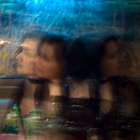Dust & Shadow in The Future of Print
Posted Nov. 27, 2020 by Nik Gaffney and Maja KuzmanovićHow can immersive experiences stimulate engagement with printed books in a library? More specifically, in a university library "how do students interact with reading materials that are embedded in an immersive learning experience tied to an interesting topic? Additionally, how can we use our print collections to collaborate with and support faculty research?"
To answer these questions we worked closely with the librarians of The Future of Print. Last year, we temporarily transformed a study room of the ASU Library in Arizona into a Dust & Shadow Acoustic Ecology Salon – a study room, an immersive installation and a portal into a parallel present or a possible future.
Here's what the collaboration looked like from a librarian's point of view.
Excerpts from The Future of Print Report: Dust & Shadow by Emily Pattni, Curation Specialist
"Dust and Shadow was an opportunity to bring our communities into the Library space to learn about an important research topic, think critically about their own experiences, and engage with library resources."
"We added science fiction, critical texts, memoirs,and photography books in the space inspired from their list of research influences.These books were placed throughout the room, amongst the wooden beams and artifacts. We also worked with the Map and Geospatial Hub and the Arizona Collection to reproduce maps and archival images showing the desert regions. In this way, we were able to feature print books in a fully-immersive sensory experience to encourage discovery, learning, and engagement.
To create a book list that supported this theme, I referenced Maja, Nik, and Ron’s list of influences and their project’s bibliography. I identified other related books and worked with Joyce Martin, then the Curator for the Labriola National American Indian Data Center, to add works about how Indigenous communities in Arizona interact with the lands where they have lived and continue to live today. The final book list has 112 titles featuring authors like Ofelia Zepeda, Charles Stross, and China Mieville. We already owned 56 items, and we purchased 56 items for this collection.
Comparing loans during the project dates to the highest loan period in previous months, we can see a 29% increase in circulation. Comparing this to each day since 2017, we observe a 190% loan increase. This means these books loaned nearly three times as often than on an average day. Overall, these books saw the most circulation while the installation was in place.
Students and staff responded with curiosity and wonder, providing informal feedback that they wanted to spend more time in the salon. They interacted with the room by taping images to the white board and writing responses to the prompts. One student commented that the Library “should do more stuff like this.”
We learned new strategies to designing print collections using space, senses, and art to engage users. Additionally, these books have been a great addition to our collection beyond the project dates, because they continue to circulate and have been used for other projects. The relationships formed in this project have reinforced the Library’s value for researchers, and have fostered conversations around how we can continue to design learning experiences that invoke curiosity and interest."
Emily's full report can be found here.
Created: 15 Jul 2021 / Updated: 04 Apr 2023








